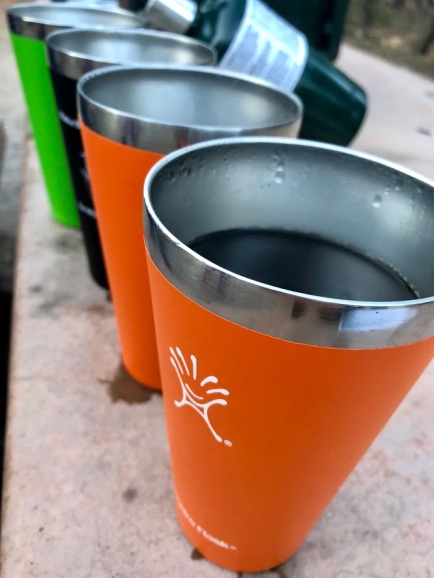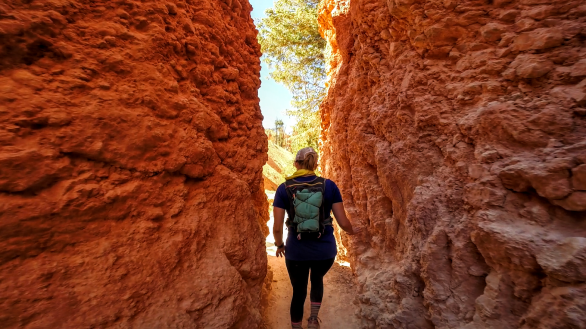
It’s no secret that travel has an impact on the environment. That definitely doesn’t mean that you should forgo all plane and car travel – there are just too many beautiful places to explore and adventures to be had. Here are some packing (and shopping) items and tips to help keep your trip as green as possible.
Insulated cup or mug
Ditch disposable cups and carry along a cup of your own for your early morning airport coffee, daily campsite coffees, and post-adventure libations. We love our hydroflask insulated pint glasses, but any re-usable drinking vessel will do.

Water bottle
From the airport to the trails and back, a water bottle is an essential item on your green packing list. If you don’t have one at home, pick one up and carry it with you all the time! A one liter capacity is a great size for staying hydrated without feeling like you are carting around a milk jug (one favorite among hikers is the tall, skinny smart water bottle – perfect for stashing in a side backpack pocket and compatible with the sawyer squeeze screw-on water filter). Insulated bottles are great, but can be a little heavy, so weigh (get it?) the pros and cons before adding one to your carry-on.

Re-usable bags
Limiting single use plastics is a major way to excess trash. There are many options available that pack up into tiny squares or pouches and can be easily stashed in luggage. You will avoid excessive plastic bag use, and will be ready for the cities and towns that require you to have your own bags. Forget your shopping bags? Don’t even bother with grocery bags at all! Put the groceries back into your cart after purchase and then just load them straight into the storage bins and refrigerator in the van.
But what about snacks? There are a few environmentally friendly options here.
- Bring a reusable sandwich-size bag from home to use. Stasher bags are a popular brand, but there are others out there as well. A couple of regular plastic sandwich or quart bags from your home stash are also a reasonable option – stick them in your luggage and reuse them throughout your trip.
- Paper bags are great for packing up dry snacks such as trail mix, or even sandwiches.
- Aluminum foil can be used to wrap sandwiches or form little packets for snacks. Re-use the pieces, and clean and recycle them when you are done!

Spork
This little beauty is the gift that keeps on giving. You can eat pretty much anything with it, and avoid the plastic utensils in the airport, campsite, gas station, cafeteria…. wherever! There are plastic, aluminum, titanium models so choose your favorite and get to snacking (sustainably!)
Bar Soap/shampoo
Ditch the plastic packaging and pick up a bar soap to use for your campsite bathing and cleaning. You can easily find a castile soap (like Dr. Bronner’s) in bar form, especially if you plan ahead and order one to take with you. United by Blue also makes a biodegradable bar soap. Make sure your soap is biodegradable if you plan to use it in the outdoors, and never use soaps within 200 feet of a natural water source such as a lake or stream.
Menstrual Cup
Menstrual cups have been getting a lot of attention lately as an environmentally-friendly alternative to traditional pads and tampons. They are easy to use and eliminate the trash associated with more traditional products. The cups are small and easy to stash in a bag, so there will never be any surprises (no one wants to be searching out a store to buy feminine products in the middle of nowhere during a camping trip). They also eliminate the need to pack out used feminine products during a long hike or backcountry camping trip (yuck).

Non-Toxic Sunscreen
Sunscreen is incredibly important, to reduce the risk of developing skin cancer from unprotected sun exposure. Many traditional sunscreens, however, contain chemicals that are dangerous to the environment – especially aquatic environments. Fortunately, there are alternatives. Seek out sunscreens that are free of oxybenzone and octinoxate, chemicals which are damaging to coral reefs and other aquatic creatures (mineral based sunscreens are considered effective and more environmentally friendly). Use UPF clothing and wear a hat to help to block harmful ultraviolet rays from the sun, cutting down on the amount of sunscreen you will need to apply to exposed skin.
What products do you swear by while on the road or trail? How have you helped to eliminate waste while traveling?
Source link
